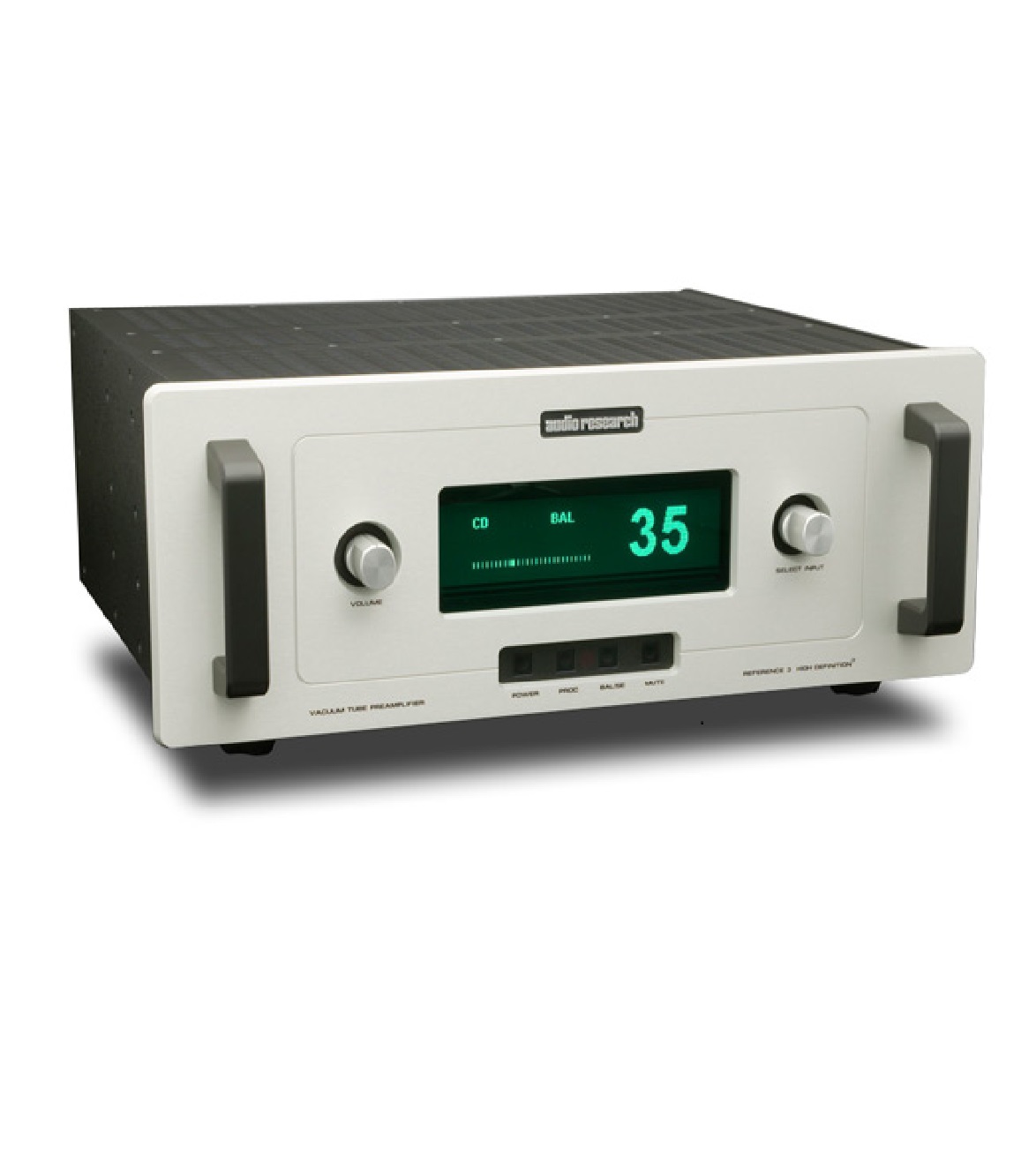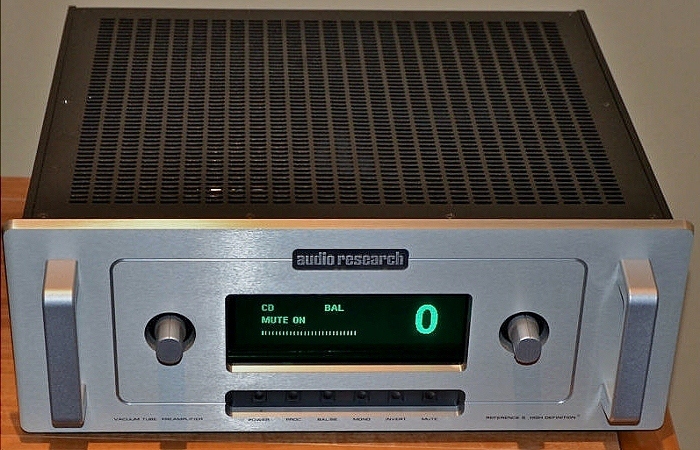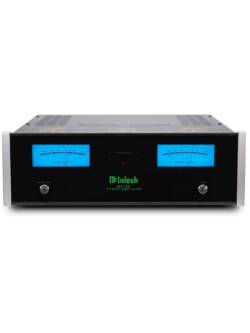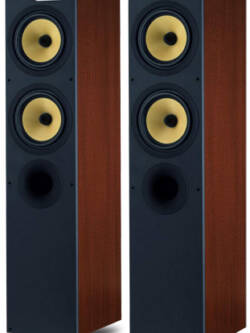Audio Research Reference 3 Preamplifier
Original price was: R130,000.00.R44,000.00Current price is: R44,000.00.

Eschewing obfuscations
The truly great components I’ve experienced have grabbed me immediately, and from the first note I heard through the ARC Reference 3 it was evident that, like the Halcro dm58 amplifier, it would prove to be a paradigm-shifting component. From the get-go, the Ref.3 presented unprecedented amounts of information organized in a way previously unknown to me. With the first CD I played, there seemed to be so much going on, and in such a deep and richly detailed sonic picture, that I wanted to “look everywhere” at once. It took a while before I was able to focus on specifics.
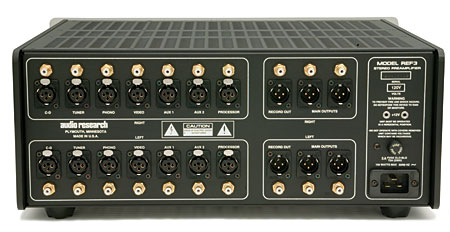
The most immediately obvious quality of the Ref.3 was its way with spaces. Anatole Fistoulari and the Concertgebouw Orchestra’s recording of scenes from Tchaikovsky’s Swan Lake (UK LP, London CS 6218 blueback) is one of the all-time great recordings of the sound of an orchestra and concert hall. The sound billowed out into my room with lush multidimensionality and majestic sweep, the way live music does, and I had an inescapable sense of not just space, but of a particular space. Similarly, the epic soundstage Bert Whyte captured on John Antill’s Corroboree (LP, Everest/Classic SBDR-3003) was confoundingly lifelike and forcibly imposed on my room.
After my first reaction of pleased shock, I noticed that the widths of these LPs’ soundstages did not diminish at all with the apparent increase in depth. Full upstage width was retained to the furthest corners at the stage’s rear. The results were equally stunning with rock and electronic music. Pink Floyd’s “Marooned,” from The Division Bell (LP, Columbia C 64200), and “Prodemium,” from Armin van Buuren’s 76 (CD, Ultra L 1168-2), showed bogglingly wide and deep soundfields that sounded every bit as internally coherent as the gorgeous sound of the Amsterdam Concertgebouw.
Second, I noticed that the spatial relationships between instruments and voices in those soundfields were explicated in unusual and surprising ways. Every recording I played through the Reference 3 allocated more elbow room to each voice and instrument than any line stage I had previously heard. The distances between sound sources were defined with much more precision than I was used to hearing. Complex music of all kinds made more spatial sense through the Ref.3, and this clarified both the sonic and musical pictures to striking degrees.
I found nothing to even quibble about, and much to be awed by, in the Ref.3’s dynamic presentation. Corroboree is a piece of explosive dynamic contrasts and percussive climaxes. The ARC delivered them all in full force, effortlessly and invisibly. In the first movement of György Ligeti’s Apparitions, in a reading by Jonathan Nott and the Berlin Philharmonic (CD, Teldec 88261-2), there is a thunderous percussion outburst that emerges from complete silence. Even though I knew it was coming, I almost literally jumped out of my chair in shock when I heard it through the Ref.3. It wasn’t just a big moment in the music—it was startling on the subconscious level.
The big ARC had the fast-twitch reflexes of an Olympic athlete, and its monster tube-regulated power supply was almost certainly the main reason why. I’ve always found there to be something special about components with big tube-regulated supplies. Their dynamics seem more fluidly continuous and less “stepped” from one level to the next. The Ref.3 certainly advances that tradition to lofty new heights.
Remember that silence I mentioned a few paragraphs back? It’s the principal reason the Reference 3 had a resolution floor that had to be heard to be believed. Listening to the Quartetto Italiano’s performances of Beethoven’s “Rasumovsky” string quartets (Italian LP, Philips 6998 017), I realized that the Ref.3 seems to increase the music’s complexity—music’s natural complexity—by paring away a layer of distortions and limitations that I had taken for granted. Attacks and decays had a special clarity and individuality even when notes were softly played.
Timbrally, the Reference 3 was a clear advance over its predecessors. The Ref.2 Mk.II tended to be overgenerous in the bass and a little loosey-goosey in terms of low-frequency definition. The Ref.3 may not have had the last bit of iron-fisted bass control that characterizes the very finest solid-state line stages, but it combined the best of both in beautiful proportion. “Marakech” and “Henry,” from Peter Kruder’s Peace Orchestra (CD, G-Stone G-CD 004), had impressive weight and depth with no slop or overhang, only poised authority. Down in the depths, the ARC preamp exhibited excellent control without sacrificing its ability to let each instrument project sound into space in its own unique way. It did not sacrifice bloom on the altar of restraint. In the mid- and upper-bass ranges, the Ref.3 was exceptionally well balanced and authoritative with all manner of music.
The midrange has been a traditional Audio Research strength, and the Ref.3 represents its finest achievement in that area. Its fundamental neutrality was complemented by the sort of intensely saturated tonal colors heard almost exclusively from live music. It did so not by actively adding anything that wasn’t on the recording—it didn’t—but by allowing a higher level of completeness to at last be heard. In short, what the Ref.3 seemed to “add” was an extra level of clarity and resolution. Instruments and voices projected from my Wilson MAXX 2s into the room with a shivery sense of solidity and realness. Claudio Arrau’s performance of Liszt’s Transcendental Etudes (Dutch LP, Philips 6598 490) had a real presence and grandeur that the music demands. Voices were a constant joy through the Ref.3. Whether Ian Dury’s Cockney growl, Julee Cruise’s wispy soprano, or anything in between, the ARC stood out for the unvarnished naturalness of its presentation. In the top octaves, the Ref.3 had an exceedingly open and detailed sound that was free of highlighting, grain, or artifacts.
The almost witchily organic sensuality of the Ref.3’s sound derived primarily from its seamlessness across the board. Music flowed through the big ARC unimpeded by any audible distortion or subtraction with which I am acquainted—it simply happened, with no sense of “re-presentation.” The Ref.3 is one of the tiny handful of components of my experience that presented recordings as contemporaneous musical events rather than as museum exhibits. It sounded as if the “frame” of traditional hi-fi colorations had been removed because it had.
What was endlessly fascinating was the Ref.3’s ability to capture the character and intent of all the music I put through it. From the intense paranoia and angst of Van Der Graaf Generator and the majesty of Arrau’s Liszt to the gossamer textures of Enya’s “Caribbean Blue,” from Shepherd Moons (CD, Reprise 26775-2), the Ref.3 always caught the inexplicable intangibles that bring music to life. Any component that can bring me to the edge of my chair with something as familiar and pedestrian-sounding as Linda Ronstadt’s cover of “You’re No Good” is doing something remarkable indeed. I’m not sure any word or phrase in the current audiophile vocabulary precisely describes it.
“I’d rather know than believe.”—Carl Sagan
Audio reviewers are regularly excoriated for saying that the Cosmic Kaboom Z-1 is “the best,” only to say a few months later that the Planetsmasher Egomania 5000 is now the best of the best and the new state of the art. This is not evidence of conspiracy or caprice or bribery, but the inevitable result of the last decade’s advances in all aspects of audio design and manufacturing. Today’s finest audio gear is so good that ever-smaller or previously unheard differences are now much more apparent and important.
One factor in this is the boggling increase in broadband resolution available from modern cutting-edge speakers. Higher-ups at both Wilson Audio Specialties and Audio Research Corporation have told me that the reason each of their companies’ current products are so good is because of what the other company’s latest products are now able to reveal to them about their own efforts. Such symbiosis breeds improvement all around in an evolutionary loop of constantly increasing knowledge. Differences that would have been virtually inaudible with the best gear of only 10 to 15 years ago are now impossible not to hear.
Occasionally one hears a piece of gear that flat-out transcends its preexisting competition in one or more areas, whether it be reducing colorations or providing higher and deeper resolution or more lifelike dynamics. It provides performance not previously available and, in turn, will reveal relative weaknesses in components previously (and properly) thought to be the state of the art. One can’t recognize that the previous standard-setter has been bested until it is bested, and it doesn’t mean that owners of the “old” best now need moan and wring their hands. The images produced by the Keck telescopes are still spectacular, even though the Hubbell telescope’s are even better.
In his classic The Structure of Scientific Revolutions, Thomas Kuhn observed that a dominant paradigm holds sway until enough irregularities and inconsistencies emerge to require the old paradigm’s adaptation to or replacement by a new theoretical framework or paradigm. So it is in audio. Issues that were struggled with for decades have been resolved, and as a result, the next wave of improvements in music reproduction depends on getting correct a range of subtleties that were once irrelevant or, at most, peripheral. As Brian Damkroger observer in his August 2006 review of the Halcro dm88 power amplifier, when the playing field is fundamentally changed, new things emerge as critical, and we struggle to precisely define and describe these new, nontraditional, qualities.
That said, the Audio Research Reference 3 is the single most impressive and thought-provoking piece of electronics I have heard since the Halcro dm58 (see my review in Stereophile, October 2002, Vol.25 No.10). Like the dm58, the Ref.3 has radically changed my expectations of what is possible in the electronic arts. The Ref.3 sets new standards for quietness in the realm of tube line stages, and in that respect is competitive with any solid-state design I have heard. In terms of resolution, timbral generosity and accuracy, soundstaging, dynamics, and the holistic presentation of music as a whole thing, it is the best I have heard (footnote 1).
As I wrote about the Halcro, discovering the weaknesses of the Reference 3 will be possible only when it has been bettered. That it will inevitably be surpassed is the nature of a constantly evolving industry such as high-end audio. I do not envy those who will attempt to do so, for they have a steep and brutally challenging mountain to scale. That much—and that Audio Research’s well-earned reputation for excellence continues—I do know.
